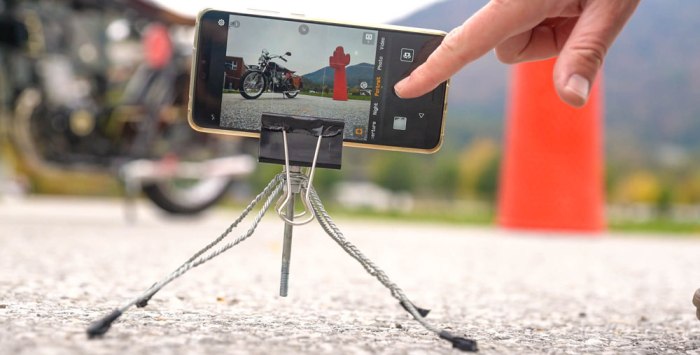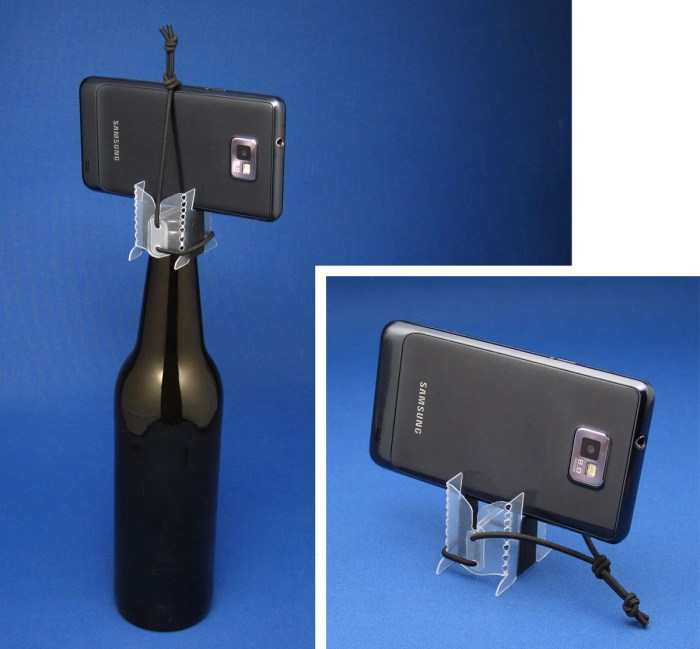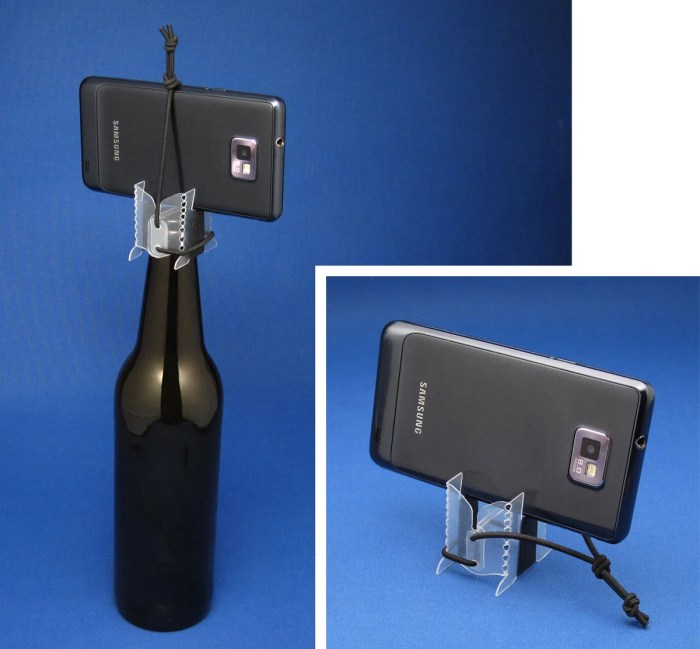DIY phone tripod sets the stage for this enthralling narrative, offering readers a glimpse into a story that is rich in detail and brimming with originality from the outset. This guide explores the world of building your own phone tripod, from basic construction to innovative designs. Whether you’re a seasoned photographer or a curious beginner, this journey promises to equip you with the knowledge and inspiration to create a personalized and practical tool for capturing stunning visuals.
This guide explores the fundamental components of a phone tripod, delves into design considerations for stability, and showcases creative and adaptable designs that go beyond the traditional setup. We’ll discuss the benefits of DIY phone tripods, including cost-effectiveness, sustainability, and the ability to personalize your setup. We’ll also touch upon the importance of safety and durability, ensuring that your DIY phone tripod is not only functional but also reliable.
Design Considerations for Stability

A stable tripod is crucial for phone photography and videography. A shaky tripod can result in blurry images and videos, ruining your efforts. Choosing the right tripod legs and incorporating features for enhanced stability can significantly improve the quality of your shots.
Choosing Tripod Legs for Different Surfaces and Scenarios
The type of tripod legs you choose depends on the surface you’ll be using it on and the type of photography or videography you’re doing.
- For smooth surfaces like tables and desks, you can use a tripod with thin legs that can easily grip the surface.
- For uneven surfaces like grass or sand, consider a tripod with wider legs or adjustable leg angles for better stability.
- For outdoor photography in windy conditions, a tripod with a heavier base or adjustable legs that can be spread out wide will provide more stability.
Design Features for Enhanced Stability
Here are some design features you can incorporate into your DIY phone tripod to improve its stability:
- Adjustable Legs: Adjustable legs allow you to customize the tripod’s height and angle, ensuring a stable base on uneven surfaces.
- Weighted Base: A weighted base adds extra stability to the tripod, especially in windy conditions. You can use sandbags, rocks, or other heavy objects to weigh down the base.
- Center Column Lock: A center column lock prevents the column from accidentally sliding out, which can cause the tripod to collapse.
- Tripod Head with Pan and Tilt: A tripod head with pan and tilt allows you to easily adjust the angle of your phone, providing more creative control over your shots.
DIY Phone Tripod Design with Enhanced Stability
Here’s a simple DIY phone tripod design that incorporates features for enhanced stability:
Materials:
- Wooden dowels (different lengths)
- Wooden blocks
- Screws and nuts
- Sandbags or other heavy objects
- Phone holder (optional)
Instructions:
- Cut the wooden dowels to different lengths for the tripod legs.
- Attach the dowels to the wooden blocks using screws and nuts.
- Attach the phone holder to the top of the tripod using screws and nuts.
- Place sandbags or other heavy objects on the wooden blocks to create a weighted base.
- Adjust the tripod legs to achieve the desired height and angle.
This design provides a stable base for your phone, thanks to the adjustable legs and weighted base. You can customize the design by using different materials and adding features like a center column lock or a pan and tilt head.
DIY Phone Tripod Accessories
A DIY phone tripod, while functional, can be enhanced with various accessories to increase its versatility and improve the quality of your recordings. These accessories can add features like remote control, improved audio, and better lighting, making your phone tripod a more powerful filmmaking tool.
Common Accessories
Common accessories that can be used with DIY phone tripods include:
- Remote Shutters: Remote shutters allow you to trigger the camera on your phone without touching it, preventing camera shake and enabling more creative shots. These can be Bluetooth-enabled, wired, or even self-timers.
- External Microphones: External microphones can significantly improve audio quality, especially when recording videos or voiceovers. They can be clip-on microphones, shotgun microphones, or even lavalier microphones for better audio pickup.
- Lighting Equipment: Proper lighting is essential for quality videos and photos. You can use LED lights, ring lights, or even natural light sources like lamps or windows to illuminate your subject.
DIY Phone Tripod Accessory Design
Here is an example of a DIY phone tripod accessory that enhances its functionality:
DIY Phone Tripod Handle:
This accessory provides a comfortable grip for holding the tripod, making it easier to move around and shoot handheld shots. It also allows you to add additional accessories like a microphone or a small LED light.
Steps to Integrate the Handle
- Materials: You will need a piece of wood or PVC pipe, a drill, screws, and a small piece of foam or rubber for padding.
- Cut the Wood/PVC: Cut the wood or PVC pipe to the desired length for the handle. The length should be comfortable to hold and allow for easy access to the tripod controls.
- Drill Holes: Drill holes on either end of the handle, aligning them with the existing holes on the tripod legs.
- Attach the Handle: Secure the handle to the tripod legs using screws.
- Add Padding: Wrap the handle with foam or rubber padding for a comfortable grip.
DIY Phone Tripod for Specific Applications
DIY phone tripods are incredibly versatile and can be adapted to suit a wide range of photography and videography applications. By incorporating specific design elements, you can create a custom phone tripod that excels in particular scenarios.
Macro Photography
Macro photography focuses on capturing images of tiny subjects, such as insects, flowers, or intricate details. A DIY phone tripod can be tailored for this purpose by incorporating features that provide stability and precise adjustments.
- Stability: A wider base and heavier construction are crucial for macro photography. Using a sturdy base like a piece of wood or a heavy metal plate enhances stability, preventing any unwanted movement during the long exposure times often required in macro photography.
- Fine Adjustments: Macro photography demands precise positioning of the phone. Incorporating a ball head or a geared mechanism allows for fine adjustments to the phone’s angle, enabling you to capture the perfect shot.
- Macro Lens: While not directly part of the tripod, using a dedicated macro lens for your phone can significantly enhance the quality of your macro images.
Time-Lapse Videos
Time-lapse videos capture the passage of time by stitching together a series of images taken at intervals. A DIY phone tripod designed for time-lapse videography should prioritize stability and smooth, consistent movements.
- Stability: A sturdy tripod with a wide base is essential for preventing unwanted movement during the extended shooting times required for time-lapse videos. This ensures that each frame is captured consistently, resulting in a smooth and professional-looking time-lapse.
- Smooth Movements: If you want to incorporate panning or tilting movements into your time-lapse, a tripod with a smooth-operating pan head or tilt mechanism is necessary. This allows you to create dynamic and visually engaging time-lapses.
- Remote Trigger: Using a remote trigger or a timer app on your phone allows you to start and stop the time-lapse sequence without touching the phone, preventing any accidental movement that could disrupt the video.
Product Photography
Product photography focuses on capturing high-quality images of products for marketing or e-commerce purposes. A DIY phone tripod designed for product photography should prioritize stability, consistent lighting, and the ability to control the background.
- Stability: A sturdy tripod with a wide base is essential for preventing any movement during the shooting process, ensuring sharp and well-defined product images.
- Lighting: Consistent lighting is crucial for product photography. Consider incorporating a DIY light box or using external lighting sources to illuminate the product evenly.
- Background Control: A simple backdrop, such as a white sheet or a piece of cardboard, can provide a clean and professional background for your product images. You can also use a DIY backdrop stand to create a more elaborate setup.
Safety and Durability
A DIY phone tripod, while cost-effective and a fun project, needs careful consideration for safety and durability to ensure it performs its function without posing risks or failing prematurely. This involves using strong materials, secure joints, and thorough testing before putting your tripod to use.
Importance of Strong Materials and Secure Joints
Strong materials and secure joints are essential for a durable and safe DIY phone tripod. The materials you choose should be able to withstand the weight of your phone and any additional accessories, while the joints should be securely fastened to prevent the tripod from collapsing or breaking.
- Wood: While wood is a common material for DIY projects, it can be prone to warping or breaking under stress. Consider using hardwoods like oak or maple for greater strength and durability. Ensure the wood is properly dried and treated with a sealant to prevent moisture damage.
- Metal: Metal is a more robust option for DIY phone tripods. Aluminum is lightweight and strong, making it a popular choice. Steel offers greater strength but is heavier. Choose a metal that is corrosion-resistant, especially if you plan to use the tripod outdoors.
- Plastic: Some plastics can be surprisingly strong and durable, especially when reinforced with fiberglass or other materials. Consider using high-impact plastics for components that need to withstand shocks or impacts. Ensure the plastic you choose is rated for the weight and use of your phone tripod.
When using multiple materials, ensure they are compatible and can be securely joined. For example, using wood screws to attach metal components to wood might not be the most secure option.
Testing the Strength and Stability of DIY Phone Tripods
Testing the strength and stability of your DIY phone tripod is crucial to ensure it can safely support your phone and any accessories. You can perform several tests before using the tripod:
- Weight Test: Place a weight similar to your phone on the tripod head. Ensure the tripod remains stable and doesn’t wobble or collapse. If you plan to use accessories, include their weight in the test.
- Stability Test: Gently push or pull the tripod at different angles to test its stability. The tripod should remain upright and not easily tip over. You can also try shaking the tripod to simulate vibrations or wind gusts.
- Joint Strength Test: Apply pressure to the joints of the tripod to test their strength. Ensure the joints are secure and don’t loosen or break under stress. You can also try twisting or rotating the tripod to assess the joint’s durability.
If you notice any instability or weakness during testing, re-evaluate the design and construction of your DIY phone tripod. Make necessary adjustments to ensure its safety and durability before using it with your phone.
DIY Phone Tripod: A Personal Touch

A DIY phone tripod isn’t just a functional tool; it’s a canvas for your creativity. It allows you to express your personal style and artistic flair, turning a simple object into a unique and personalized piece.
Personalized DIY Phone Tripods
Beyond functionality, DIY phone tripods can be a reflection of your individual taste and interests. By incorporating unique designs and features, you can create a tripod that truly stands out.
- Upcycled Materials: Give old materials a new life by incorporating them into your tripod design. An old wooden ruler, a vintage camera lens, or even a repurposed metal pipe can add a touch of character.
- Customizable Colors and Finishes: Paint your tripod in vibrant colors, use natural wood stains for a rustic look, or apply metallic finishes for a modern aesthetic. You can even use decoupage techniques to add patterns or textures.
- Embellishments and Decorations: Add personal touches with beads, buttons, or decorative tape. You can even create custom engravings or laser-cut designs to personalize your tripod further.
Here are some examples of DIY phone tripods that showcase individual creativity:
- A tripod made from recycled cardboard and decorated with colorful paper strips. This example demonstrates the use of readily available materials and simple design techniques to create a visually appealing tripod.
- A tripod crafted from reclaimed wood and adorned with intricate carvings. This exemplifies the use of natural materials and craftsmanship to create a unique and artistic piece.
- A tripod with a minimalist design, featuring a sleek black finish and a custom-made phone holder. This example showcases the importance of form and function in a personalized DIY project.
Remember, the possibilities are endless when it comes to personalizing your DIY phone tripod. Let your creativity flow and create a tripod that reflects your unique style and personality.
Building a DIY phone tripod is an enriching experience that combines creativity, practicality, and a touch of personal expression. By following this guide, you’ll not only gain a deeper understanding of phone tripod mechanics but also discover a world of possibilities for crafting a tool that meets your unique needs and enhances your photography and videography endeavors.
A DIY phone tripod is a great way to capture those perfect shots of your backyard gatherings. If you’re planning on hosting a party, you might want to consider building a DIY outdoor bar as well. There are plenty of great ideas for outdoor bar projects on this website , and once you’ve got your bar set up, you’ll be able to use your DIY phone tripod to capture all the fun!

